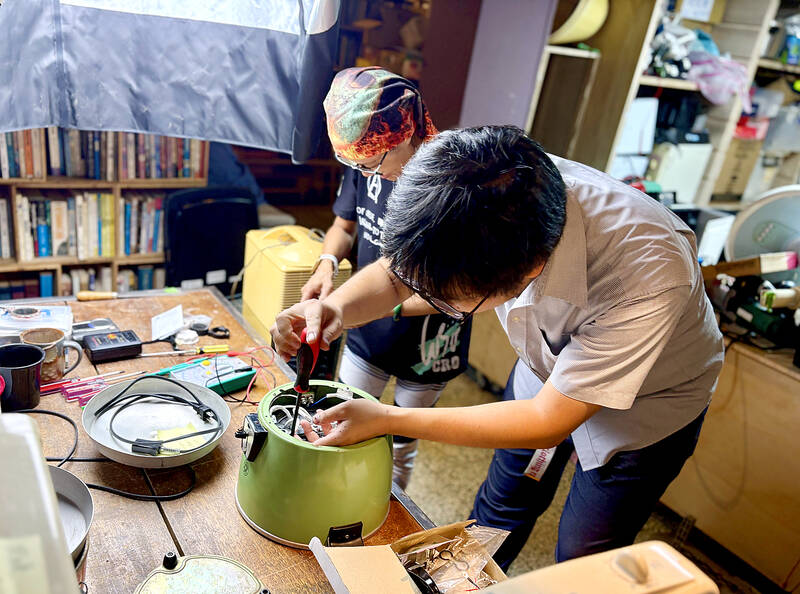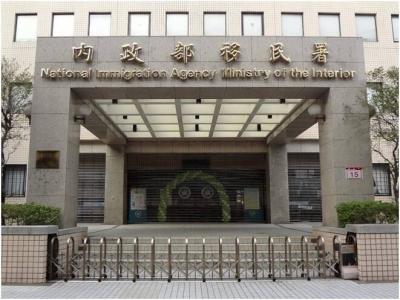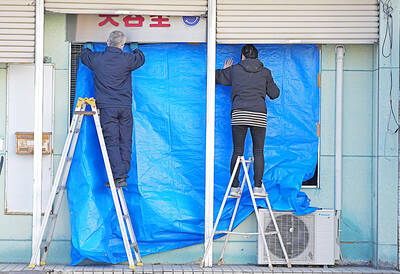Electric fans, rice cookers and hair dryers are the most often repaired small appliances, Circular Taiwan Network campaigner and Nanji Fix cofounder Yahsuan Tsai (蔡亞軒) said ahead of International Repair Day on Saturday next week.
International Repair Day falls on the third Saturday of October every year and the Ministry of Environment has commissioned the Institute of Environment and Resources to promote repair culture in collaboration with at least 33 repair communities nationwide.
Institute chairman and Deputy Minister of Environment Yeh Jiunn-horng (葉俊宏) last week said that repairing is the easiest and most economical way to reduce waste and carbon emissions.

Photo: Hunag Yi-ching, Taipei Times
Taiwan has taken part in the worldwide right-to-repair movement since 2022, he said.
The ministry organized 58 repair training sessions and 817 repair service sites have been established nationwide over the past two years, Yeh said, adding that people could visit the ministry’s national repair map (https://recycle.moenv.gov.tw/utmap/) to find the service sites.
Resource Circulation Administration Deputy Director-General Hsu Chih-lun (許智倫) said that green design and extended usage have been incorporated into the Resource Circulation Promotion Act (資源循環推動法).
The goal is to boost the durability and repairability of products by standardizing their parts and components, and making repair essentials easily accessible, he said.
Tsai encouraged people to cultivate basic repair capabilities, as many small household appliances could easily be fixed without advanced techniques.
For example, about 30 percent of seemingly broken electric fans only needed lubricant oil sprays or a new fuse, which cost less than NT$50, he said, adding that store repairs for small appliances cost hundreds of New Taiwan dollars.
The awareness of “repairing instead of replacing” should be raised and more repair sites should be set up nationwide given the massive repair demand, Tsai said.
Ensuring the right to repair by making products repairable with proper guidelines and reasonable costs is also important, Tsai added.
The government should promote easy-to-repair product designs jointly with manufacturers to extend product lifetimes by making their components easier to disassemble, maintain and replace, he said.
Nanji Fix research showed that of the small appliances brought to repair communities in Taipei, Hsinchu, Tainan, Kaohsiung and Changhua County from 2016 to this year, electric fans were the most common item that needed repairs, Tsai said.
Rice cookers were the second-most frequently repaired items, followed by hair dryers, CD players or radios, electric kettles or pots, lamps, microwaves, ovens or food dehydrators, juicers or blenders and toys, he said.
The ministry is to hold an event in collaboration with repair groups at Imma in Taipei’s Wanhua District (萬華) on Saturday and Sunday next week, where repair services for small appliances, shoes, clothing, bicycles, toys and other objects would be offered. Hands-on activities would also be held.
The first 500 participants who bring an object for repair could take home up to 600ml of laundry detergent for free, using their own container.

A small number of Taiwanese this year lost their citizenship rights after traveling in China and obtaining a one-time Chinese passport to cross the border into Russia, a source said today. The people signed up through Chinese travel agencies for tours of neighboring Russia with companies claiming they could obtain Russian visas and fast-track border clearance, the source said on condition of anonymity. The travelers were actually issued one-time-use Chinese passports, they said. Taiwanese are prohibited from holding a Chinese passport or household registration. If found to have a Chinese ID, they may lose their resident status under Article 9-1

Taiwanese were praised for their composure after a video filmed by Taiwanese tourists capturing the moment a magnitude 7.5 earthquake struck Japan’s Aomori Prefecture went viral on social media. The video shows a hotel room shaking violently amid Monday’s quake, with objects falling to the ground. Two Taiwanese began filming with their mobile phones, while two others held the sides of a TV to prevent it from falling. When the shaking stopped, the pair calmly took down the TV and laid it flat on a tatami mat, the video shows. The video also captured the group talking about the safety of their companions bathing

PROBLEMATIC APP: Citing more than 1,000 fraud cases, the government is taking the app down for a year, but opposition voices are calling it censorship Chinese Nationalist Party (KMT) Chairwoman Cheng Li-wun (鄭麗文) yesterday decried a government plan to suspend access to Chinese social media platform Xiaohongshu (小紅書) for one year as censorship, while the Presidential Office backed the plan. The Ministry of the Interior on Thursday cited security risks and accusations that the Instagram-like app, known as Rednote in English, had figured in more than 1,700 fraud cases since last year. The company, which has about 3 million users in Taiwan, has not yet responded to requests for comment. “Many people online are already asking ‘How to climb over the firewall to access Xiaohongshu,’” Cheng posted on

A classified Pentagon-produced, multiyear assessment — the Overmatch brief — highlighted unreported Chinese capabilities to destroy US military assets and identified US supply chain choke points, painting a disturbing picture of waning US military might, a New York Times editorial published on Monday said. US Secretary of Defense Pete Hegseth’s comments in November last year that “we lose every time” in Pentagon-conducted war games pitting the US against China further highlighted the uncertainty about the US’ capability to intervene in the event of a Chinese invasion of Taiwan. “It shows the Pentagon’s overreliance on expensive, vulnerable weapons as adversaries field cheap, technologically